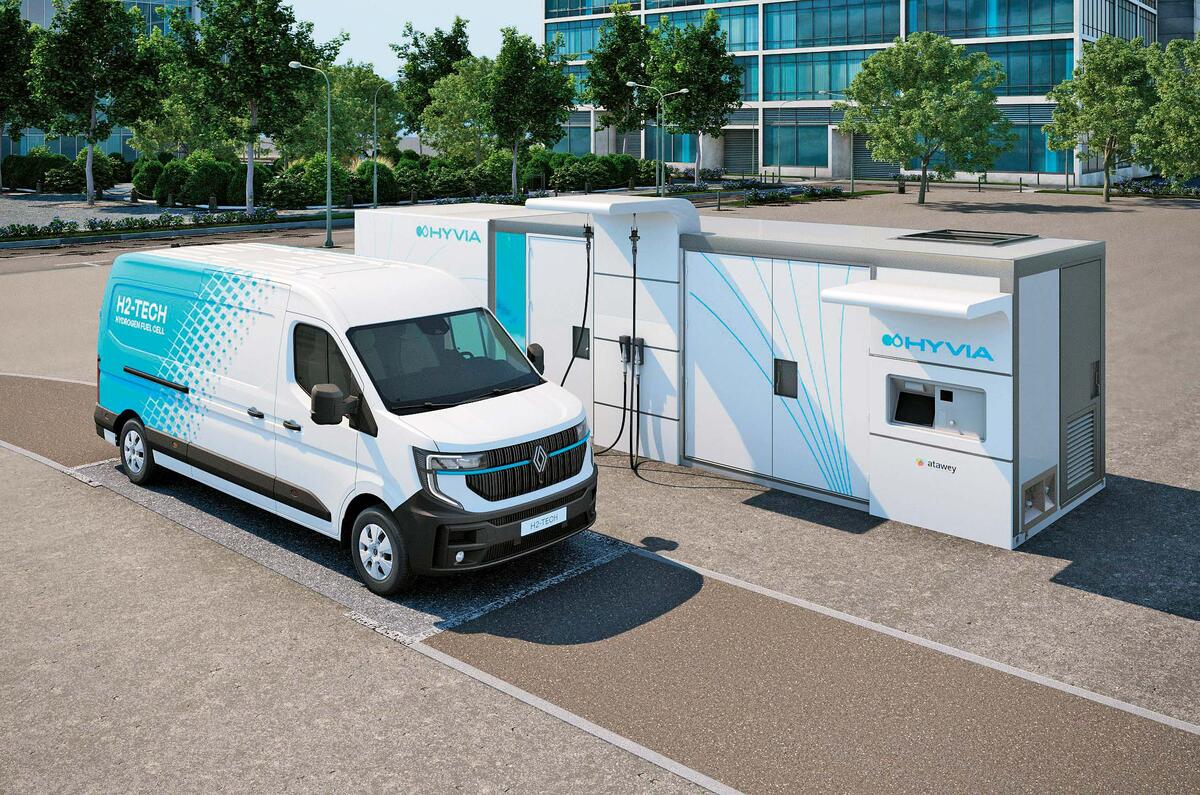Hydrogen fuel cell projects continue to grow, along with interest in using them to power commercial vehicles and particularly heavy trucks. One such is the new Renault Master H2-Tech Prototype shown at the recent IAA Transportation show in Hanover.
The Master has been developed by the Hyvia joint venture between Renault and US fuel cell specialist Plug. As part of the project, Hyvia has also developed hydrogen fuel cell stations that are being rolled out across Europe.
The significance of the project to car drivers is that commercial hydrogen fuel cell fleets have long been seen as the way to grow a hydrogen refuelling network. Hyvia’s ‘Hywell’ filling stations are clever because they are “containerised and relocatable”, making them relatively easy to set up with a minimum of engineering involved.
One station can supply 100kg of hydrogen a day, which is enough for more than 20 vehicles.
The Master H2-Tech Prototype has a WLTP range of 435 miles and can be refuelled as quickly as a petrol or diesel car. It uses a “dual-power” architecture: a combination of 47kW fuel cell and a 20kWh battery pack.
The fuel cell is a new-generation system based on a Plug fuel cell and is produced at the Hyvia plant at Flins in France.
Fuel cells have an anode and a cathode in the same way as a battery and split hydrogen molecules into protons and electrodes at the anode. The protons travel through an ultra-thin membrane to combine with oxygen from air fed into the fuel cell, and it forms water as a by-product along with heat.
The electrons flow into a circuit to power the electric traction motor, so the combination of fuel cell and small battery replace what would be a large high-voltage battery in a BEV.
The advantage over a BEV is a much longer range and quick refuelling, but the driving experience is the same as that of a BEV. Fuel cells for vehicles are usually combined with batteries to create a reservoir of energy for the transient boost needed for acceleration, while the fuel cell generates a steady flow of power to top up the battery.
The heat generated by Hyvia’s system is used for cabin heating, and the fuel cell uses compressed hydrogen stored in tanks under the floor. There’s a choice of tanks available depending on the range requirement, holding either 7.5kg or 9kg of hydrogen.
Power comes from an AC traction motor and, like a BEV or conventional hybrid, regenerative braking allows energy to be captured when the vehicle slows.





Join the debate
Add your comment
The interesting bit are the relocatable H fuelling stations - electric powered H generators with tank. Run on cheap or even free night-time electricity... makes sense. I see Aberdeen has some already...
A mobile station that can refill 13 vans before running out itself is laughable. To pay for the fuel and driver for a day alone would cost around £250 a day meaning it'll add £20 to the refuelling cost of each van, plus, you'll need to add on the cost of buying an approxiamate 200k worth of hydrogen tanker to park up at the roadside for a day to collect just £2000 worth of fuel sales.
The only glimmer of hope for Hydrogen in this story is the 20kwh battery which is almost almost an admission that the idea is dead in the H2O.
FCEV require a battery to store power for start-up operations, the fuel cell will be conditioned with the power stored in the battery and all ancilleries will be run off of it. The battery can also be charged independantly and serves as storage for energy recovery and is redundant in constant power operation.
These vans are not expected to do 700km a day though, their application is in urban areas and current EV delivery routes are 100-180km/day in my experience, the majority of that distance is from fulfilment centre to delivery area, efficient motorway driving. So 100kg of hydrogen may be able to fuel a fleet of 35 vans for a day. Assuming battery range of 100km is sustained by the fuel cell.
I'm fully aware of the need for a battery in a hydrogen vehicle, it is usual only a short term storage device of around a couple of kWh.
Your figure of average of 2.8kg filling per van is plain wrong, why get a 60k van which only has an electric range of 50 miles. They're pimping up the range of these vans for people who do big miles per day so drivers puting in 2 kilos to gain 60 miles twice a day doesn't cut it.
Either way the finances don't add up on the filling side of things as per my example.